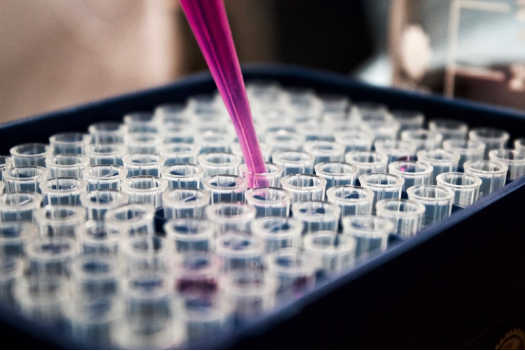
CUT&Tag(Cleavage Under Targets and Tagmentation)是一種建立在CUT&RUN和ChIC基礎(chǔ)上的創(chuàng)新型表觀基因組分析測定方法�����。CUT&Tag檢測方法由Dr. Steven Henikoff的實驗室研發(fā)�����,并于2019年首次報道����。CUT&Tag技術(shù)的核心是在Tn5上融合了protein A/G抗體結(jié)合功能域的轉(zhuǎn)座體pAG-Tn5��。
?
與ChIP-seq相比CUT&Tag的優(yōu)勢
●?更快:可以在兩天內(nèi)完成從細胞到文庫的建立�����,而ChIP-seq需要五天(或更長時間)��。
●?更少的細胞:CUTANA?CUT&Tag分析僅使用1000個細胞核即可生成高分辨率的圖譜���,甚至可用于單細胞水平測序����。ChIP-seq需要數(shù)百萬個細胞來進行高質(zhì)量測序����,不利于單細胞或珍貴樣本的分析�����。
●?提高信噪比:即使使用較少的起始細胞也能得到較低的背景信號和較強的目的信號�����。
●?無需文庫準備步驟:通過在抗體結(jié)合的目標位點添加測序適配器��,CUT&Tag可以跳過傳統(tǒng)的庫準備步驟(end repair, adapter ligation)�,極大地簡化了實驗步驟����。EpiCypher的CUTANA CUT&Tag分析通過直接從反應(yīng)混合物中擴增標記DNA進一步簡化了這一策略,允許用戶在一個管中從細胞到PCR文庫擴增����。
● 低成本:與ChIP-seq(需要約3000萬次讀取)相比,CUT&Tag檢測僅需要300-800萬次測序讀取�����,節(jié)省了70%的成本。
?
2022年許多利用CUTANA? CUT&Tag技術(shù)進行分析研究的文獻被發(fā)表�,快速的推進了表觀遺傳學(xué)的研究。下面是其中一些文獻的簡要示例���,因其對EpiCypher CUT&Tag產(chǎn)品和實驗步驟的獨特應(yīng)用而脫穎而出。希望這些文獻能為您的實驗提供一些靈感���!
1.?Tumor microenvironmental signals reshape chromatin landscapes to limit the functional potential of exhausted T cells
Ford et al. Science Immunology, 2022.?PMID:?35930654
細胞類型:?FACS-sorted tumor-infiltrating CD8+ T cells (exhausted cell states), effector CD8+ T cells from draining lymph nodes (control); all cells from mouse?B16F10 melanoma mouse model
目標蛋白:?H3K4me3, H3K27me3
主要內(nèi)容:?T cell exhaustion?is an important mechanism associated with cancer immunotherapy resistance. Combating T cell exhaustion requires studying the entire cellular progression from progenitor to terminally differentiated exhausted T cells, including changes to chromatin structure. In this paper, Ford et al. applied ultra-sensitive CUTANA CUT&Tag technology to map open and repressive chromatin during exhausted T cell development. The reduced cell requirements of CUT&Tag enabled high-resolution profiling of multiple histone PTMs from the FACS-sorted cell populations, which revealed distinct chromatin features linked with T cell exhaustion. The authors used these data to identify new epigenetic-based strategies for reactivation of exhausted T cells, pointing to new avenues for immunotherapy-resistant cancer research.
上榜理由:本文強調(diào)了CUTANA CUT&Tag技術(shù)在分析罕見或小細胞群(包括流式細胞分析儀分選的免疫細胞)方面的優(yōu)勢�。
?
2.?Characterizing cellular heterogeneity in chromatin state with scCUT&Tag-pro
Zhang et al. Nature Biotechnology, 2022.?PMID:?35332340
細胞類型:?Frozen PBMCs from healthy human donors
目標蛋白:?H3K4me1, H3K4me2, H3K4me3, H3K27ac, H3K27me3, H3K9me3, Phospho-Rpb1 CTD (Ser2/Ser5)
主要內(nèi)容:?In this paper, Zhang et al. used?CUTANA pAG-Tn5?to establish single-cell CUT&Tag-pro (scCUT&Tag-pro), a platform that merges CUT&Tag with detection of cell surface proteins in individual cells. For proof-of-concept, scCUT&Tag-pro was used to profile a collection of histone PTMs in PBMCs. Each experiment mapped one histone PTM per cell with simultaneous detection of common immune cell surface proteins. Individual cells across data sets could be grouped by cell surface markers, and then further separated by chromatin profiling results. These data were combined with publicly available scRNA-seq data to create single-cell “metaomic” profiles.
上榜理由:Zhang等人為異質(zhì)細胞群中染色質(zhì)狀態(tài)的綜合化分析提供了新的工具����。同時還強調(diào)了CUTANA表觀基因組技術(shù)如何應(yīng)用于特定用戶的平臺開發(fā)。
?
3.?Nuclear RIPK1 promotes chromatin remodeling to mediate inflammatory response
Li et al. Cell Research, 2022.?PMID:?35661830
Bonus:?Also uses?EpiDyne-FRET?chromatin remodeling assays!
細胞類型:?Mouse embryonic fibroblasts from Ripk1 mutant mice (untreated, TNFα stimulation, TNFα stimulation + RIP1K inhibitor); spinal cord tissue from patients with amyotrophic lateral sclerosis (ALS) and healthy patients
目標蛋白:?p-S166-RIPK1 (active RIPK1), SMARCC2, BRG1/SMARCA4, H3K4me1, H3K27ac
主要內(nèi)容:?Receptor-interacting serine/threonine-protein kinase 1 (RIPK1) modulates cell responses to TNFα cytokine signaling and is linked to increased expression of inflammatory genes in neurodegenerative disease. Although several?RIPK1 inhibitors?have progressed to clinical trials, the mechanism connecting RIPK1 to transcriptional changes is still unclear. In this paper, Li et al. find that RIPK1 regulates SWI/SNF BAF chromatin remodeling activity at inflammatory genes, increasing chromatin accessibility and promoting gene expression. CUTANA CUT&Tag assays provided key data from cell lines, mouse models, and ALS patient samples, confirming co-localization of RIPK1 and SWI/SNF enzymes at TNFα-induced genes.
上榜理由:了解外部信號(如細胞因子)如何與染色質(zhì)調(diào)控聯(lián)系在一起��,對于識別新的藥物靶點和更有效的治療非常重要�。整個研究過程CUTANA CUT&Tag起到了很重要的作用。
?
4.?Epigenetic reader SP140 loss of function drives Crohn’s disease due to uncontrolled macrophage topoisomerases
Amatullah et al. Cell, 2022.?PMID:?35952671
細胞類型:?Primary human macrophages (control and with siRNA-mediated SP140 knockdown)
目標蛋白:?TOP1, TOP2A
主要內(nèi)容:?Genome-wide association studies (GWAS) for?immune diseases?have identified multiple risk variants associated with chromatin. Here, Amatullah et al. investigate the function of SP140, an epigenetic reader protein with variants in Crohn’s disease, chronic lymphocytic leukemia, and multiple sclerosis. Using a series of mass spectrometry, cell culture, and CUTANA CUT&Tag experiments, the authors demonstrate that SP140 suppresses?topoisomerase?activity in healthy cells. GWAS variants of SP140 lead to changes in chromatin accessibility, activation of developmental genes, and defective antimicrobial responses. Treatment of inflammatory bowel disease (IBD) models with topoisomerase inhibitors improved phenotypes specifically in SP140 mutant mice, supporting further exploration for personalized medicine applications.
上榜理由:免疫疾病的全基因組關(guān)聯(lián)研究(GWAS)已經(jīng)確定了與染色質(zhì)相關(guān)的多種風(fēng)險變異��。Amatullah等人研究了SP140的功能�����,通過質(zhì)譜��、細胞培養(yǎng)和CUTANA CUT&Tag分析���,證明了SP140抑制健康細胞中的拓撲異構(gòu)酶活性���。文章還強調(diào)了突變位點為治療提供了潛在信息�。
?
相關(guān)產(chǎn)品推薦
產(chǎn)品名稱 | 貨號 | 規(guī)格 |
CUTANA? CUT&Tag Core Reagents Bundle | 14-1101 | 50 Reactions |
SNAP-CUTANA? K-MetStat Panel | 19-1002 | 50 Reactions |
CUTANA? pAG-Tn5 for CUT&Tag | 15-1017 | 50 Reactions 200 Reactions |
CUTANA? Fluorescent pAG-Tn5 for CUT&Tag | 15-1026 | 125 μL |
CUTANA? Uncharged pAG-Tn5 for CUT&Tag | 15-1025 | 20 μL |
Histone H3K4me3 Antibody, SNAP-Certified? for CUT&RUN and ChIP | 13-0041 | 100 μg |
Anti-Mouse Secondary Antibody for CUTANA? CUT&Tag Workflows | 13-0048 | 50 Reactions 200 Reactions |
Anti-Rabbit Secondary Antibody for CUTANA? CUT&Tag Workflows | 13-0047 | 50 Reactions 200 Reactions |
CUTANA? Rabbit IgG CUT&RUN Negative Control Antibody | 13-0042 | 100 μg |
CUTANA? Non-Hot Start 2X PCR Master Mix for CUT&Tag | 15-1018 | 50 Reactions |
CUTANA? Concanavalin A Conjugated Paramagnetic Beads | 21-1401 | 550 μL 2.75 mL |
如需了解更多詳細信息或相關(guān)產(chǎn)品����,請聯(lián)系EpiCypher中國授權(quán)代理商-欣博盛生物?
全國服務(wù)熱線: 4006-800-892? ? ? ?郵箱: market@neobioscience.com? ?
深圳: 0755-26755892? ? ? ?北京: 010-88594029? ? ? ? ?
上海: 021-34613729? ? ? ? ?廣州: 020-87615159? ? ? ? ??
代理品牌網(wǎng)站: m.smblzp.com? ?
自主品牌網(wǎng)站: www.neobioscience.net